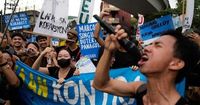On October 20, 2025, the Philippines took a remarkable—and, some would say, long overdue—step in its battle against government corruption. In a move that’s already sending ripples through the nation’s political class, authorities unveiled a brand-new jail in metropolitan Manila, specifically designed to hold up to 800 detainees. But this isn’t just any detention facility. According to the Associated Press, this newly constructed jail is intended to house some of the most powerful figures in the country: legislators, public works officials, and others accused in a sweeping corruption scandal tied to flood control projects.
The unveiling was led by Interior Secretary Jonvic Remulla, who, with a mix of candor and resolve, showed the facility to the media. Remulla explained that the new jail was built as a direct response to public outrage over the scandal—one that has implicated dozens of members of Congress, government engineers, and construction company owners. The scale of the alleged corruption is staggering, and the fallout has sparked street protests across the Philippines, a nation all too familiar with the devastating consequences of inadequate flood control.
Remulla didn’t mince words at the press conference. He estimated that about 200 officials and other suspects could soon be indicted by the Sandiganbayan, the country’s special anti-graft court for government officials. That looming wave of indictments, he said, made it necessary to construct a new facility capable of detaining suspects who may face months—or even years—of legal proceedings. "What we are preparing are regular jail cells," Remulla stated. "If a shoplifter who stole a bottle of lotion worth 100 pesos ($1.7) from a shopping mall could be detained here, the ones who stole billions and billions in my view should be similarly locked up here."
The jail itself is a stark departure from the VIP accommodations that have, in the past, been afforded to high-profile detainees. The facility comprises 80 cells, each able to hold up to 10 inmates. Inside, detainees will find bunk beds, a shared bathroom, a toilet, a shower, and purified drinking water—no frills, just the basics. As in other Philippine detention centers, cellphones, computers, and other communication gadgets are strictly prohibited. Detainees will, however, have access to their lawyers and an infirmary, ensuring that due process and basic human rights are respected. Remulla was adamant: "The same rules of the jail will apply to the rich and poor."
This emphasis on equal treatment is more than just rhetoric. Prisons in the Philippines are notorious for overcrowding and inadequate facilities, problems that have only worsened in recent years. The prison population surged during former President Rodrigo Duterte’s controversial war on drugs, a campaign that left the country’s detention centers bursting at the seams. Duterte himself now faces detention by the International Criminal Court in The Hague for alleged crimes against humanity related to drug-related killings, a grim reminder of how swiftly political fortunes can reverse in the Philippines.
The roots of the current scandal stretch back to President Ferdinand Marcos Jr.’s state of the nation address before Congress in July 2025. In that speech, Marcos sounded the alarm over massive irregularities in flood control projects—a sector that, given the Philippines’ vulnerability to typhoons and flooding, is both highly visible and politically sensitive. Shortly after, Marcos established an independent commission to investigate potential corruption in the awarding and execution of flood-control contracts. The commission’s focus: 9,855 projects worth more than 545 billion pesos (about $9.5 billion) that were supposed to have been undertaken since he took office in mid-2022.
The numbers that have since emerged are nothing short of jaw-dropping. Last month, Finance Secretary Ralph Recto reported to legislators that up to 118.5 billion pesos (more than $2 billion) worth of flood control projects may have been lost to corruption since 2023 alone. These revelations have only fueled public anger and intensified calls for accountability at the highest levels of government.
Televised congressional inquiries have laid bare the scope of the alleged corruption. According to testimony under oath from construction company owners, government engineers, and other witnesses, several legislators—including some of the country’s most powerful political figures—were allegedly allotted huge kickbacks from flood control projects. Among those named are House Speaker Martin Romualdez, a cousin and political ally of President Marcos, and Senate President Francis Escudero, along with four other incumbent and former senators. Both Romualdez and Escudero have since stepped down from their influential posts, but each has categorically denied the allegations.
The scandal has struck a nerve in a nation where the gap between rich and poor remains wide, and where perceptions of impunity for the powerful are deeply entrenched. The decision to build a jail that will treat all detainees equally—no VIP wings, no special privileges—represents a pointed attempt by the Marcos administration to restore public trust. Remulla, for his part, was unequivocal: "The same rules of the jail will apply to the rich and poor." The message is clear: those accused of stealing public funds on a grand scale will not be coddled.
Of course, skepticism remains. The Philippines has a long history of high-profile corruption cases that drag on for years, only to end with acquittals or pardons. Critics warn that building a new jail is no substitute for meaningful institutional reform, and some have questioned whether the Sandiganbayan and the independent commission will have the independence and resources needed to bring powerful suspects to justice. But for now, the new jail stands as a symbol—however imperfect—of a government trying to reckon with its own excesses.
For ordinary Filipinos, the stakes couldn’t be higher. In one of Asia’s most flood-prone countries, every peso lost to corruption in flood control is a potential tragedy waiting to happen. As the monsoon season approaches, many will be watching closely to see whether the government’s crackdown on corruption will finally deliver real change—or whether, as so often in the past, the powerful will find a way to slip through the cracks.
The opening of this jail, then, is about more than just bricks and mortar. It’s about confronting a legacy of impunity and restoring a measure of faith in the rule of law. Whether it succeeds in doing so remains to be seen, but for now, at least, the message from the Marcos administration is unambiguous: no one is above the law, and the days of special treatment for the powerful may finally be numbered.

